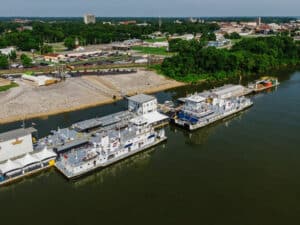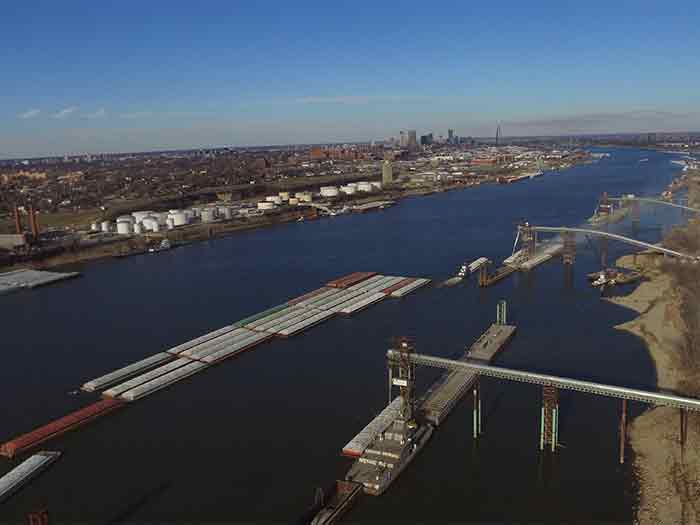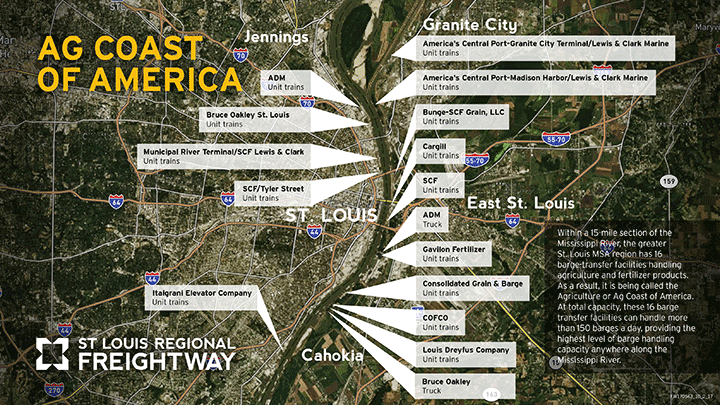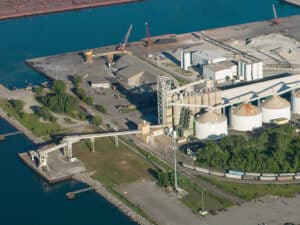
New grain terminal opens on “Ag Coast of America”
Written by Marine Log Staff
Terminal operated by Bruce Oakley, Inc. expands the existing capacity within the St. Louis region’s port system with the ability to handle at least 1,000 more truckloads of grain daily.
The St. Louis region’s claim to be the most efficient inland port in the United States has been strengthened with the recent addition of a new Mississippi River grain handling terminal in Cahokia, Ill. It increases capacity in the area known as the “Ag Coast of America,” a 15-mile stretch of the Mississippi River with 15 barge-transfer facilities that, at total capacity, can handle 150 barges a day—the highest level of capacity anywhere along the Mississippi River.
The addition of the 16th terminal, which was built by American Milling and purchased in December 2020 by Oakley St. Louis LLC, a subsidiary of Arkansas-based Bruce Oakley Inc., further expands the existing capacity with the ability to handle at least 1,000 more truckloads of grain daily.
Bruce Oakley entered the market in 2019 with its purchase of Lange-Stegmann Company, and this is its second terminal in the area. The acquisition gave Bruce Oakley control of Lange-Stegmann’s 60-acre site at Mile 182.7 on the Upper Mississippi River, which includes a barge dock, a rail yard with 23,000 feet of track, three locomotives, a truck and rail scale, and more than 153,000 tons of storage capacity.
“Bruce Oakley Inc. is very excited to have a presence in the St. Louis area,” said Justin Oakley, vice president of Bruce Oakley. “For a commodity transportation and distribution company like Oakley, St. Louis is one of the most strategic locations on the river system.”

Other facilities on the Ag Coast include the Cargill Grain Elevator, one of the busiest in the U.S.; the Bunge-SCF River Grain Terminal in Fairmont City, Ill., which is designed for more than a million bushels of permanent storage and can handle high volumes of multiple commodities simultaneously; and four facilities in Cahokia, Ill., operated by Consolidated Grain and Barge Company (CGB); and Louis Dreyfus and COFCO International Growmark, which are the four highest capacity facilities in the entire inland waterway. Facilities operated by ADM, Gavilon Fertilizer, SCF, and Italgrani Elevator Company, along with America’s Central Port and the Municipal River Terminal in St. Louis, round out the 16 barge transfer facilities currently handling the tremendous volumes of agriculture and fertilizer products flowing through the Ag Coast.
Growth on the Ag Coast is also supported by the recently completed reconstruction of Cargill Elevator Road, a vital link to Cargill’s Mississippi River grain terminal. Trucks represent 87% of the vehicles traversing the narrow roadway, and prior to the reconstruction, traffic had been limited to one lane in each direction. Federal funding of $800,000 through the IDOT Competitive Freight Program was key to advancing the $3.3 million project, which also received state and private funds.
One additional project, now partially funded, will help to address heavy traffic volumes on Illinois Route 3 at the A&S railroad crossing in Sauget, which result in more than 55,000 hours of through-traffic delays annually. Calculating the cost of delay, a proposed grade separation project would provide annual cost savings of $1.5 million for passenger and commercial vehicle drivers traveling this area and improve truck traffic reliability, safety and efficiency benefiting barge and rail rates. The overall project has multiple benefits to the region in terms of improving access to the growing business community and encouraging future business development.

![Tom Frazier aground and listing to starboard on Feb. 11, 2024. [Photo: U.S. Coast Guard]](https://www.marinelog.com/wp-content/uploads/2025/06/Towboataground-300x225.jpg)


